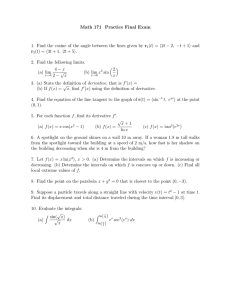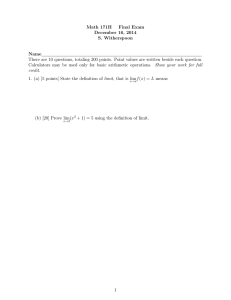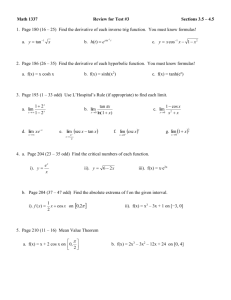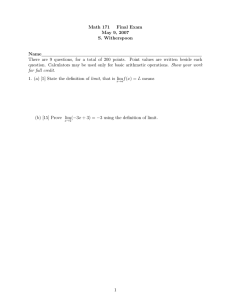Document 10427249
advertisement
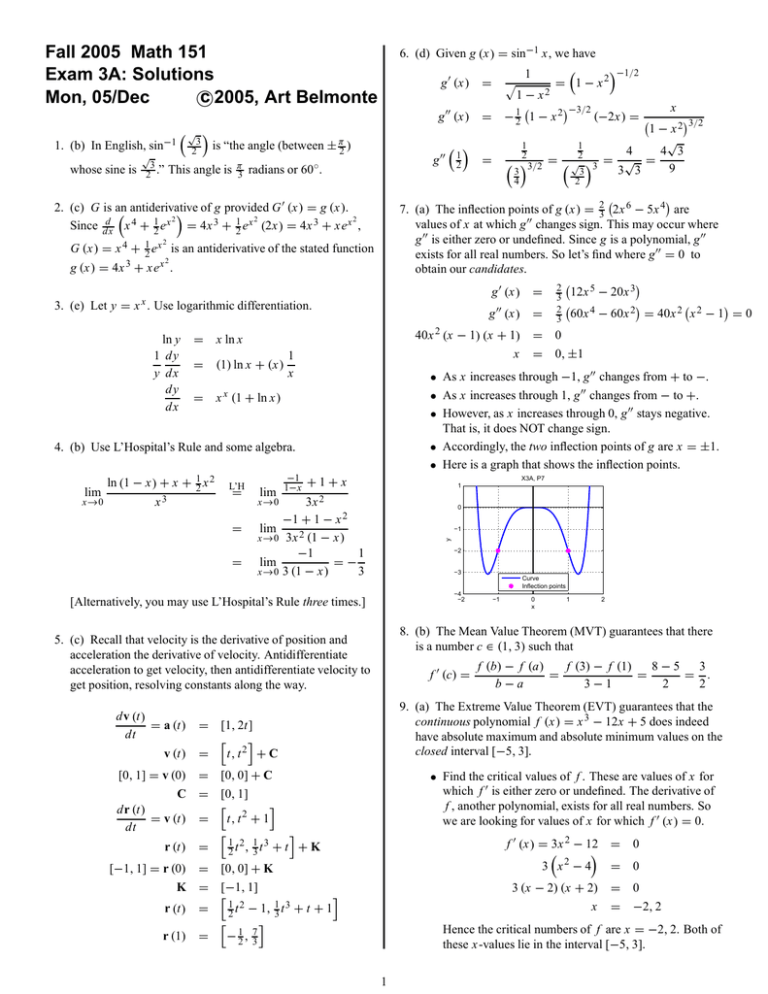
6. (d) Given g (x) = sin−1 x, we have −1/2 1 = 1 − x2 g 0 (x) = p 1 − x2 −3/2 g 00 (x) = − 12 1 − x 2 (−2x) = Fall 2005 Math 151 Exam 3A: Solutions c Mon, 05/Dec 2005, Art Belmonte 1. (b) In English, sin−1 whose sine is √ 3 2 .” √ 3 2 is “the angle (between ± π2 ) This angle is π 3 g 00 radians or 60◦ . 2 G (x) = x 4 + 12 e x is an antiderivative of the stated function 2 g (x) = 4x 3 + xe x . 3. (e) Let y = x x . Use logarithmic differentiation. = x ln x = (1) ln x + (x) = x x (1 + ln x) x3 L’H = = = lim 1 x −1 1−x +1+x 3x 2 −1 + 1 − x 2 lim x→0 3x 2 (1 − x) 1 −1 =− lim 3 x→0 3 (1 − x) 0 −1 −2 −3 Curve Inflection points −4 −2 C dr (t) = v (t) dt = [0, 1] h i = t, t 2 + 1 i h 1 2 1 3 t , t + t +K = 2 3 r (t) r (1) −1 0 x 1 2 8. (b) The Mean Value Theorem (MVT) guarantees that there is a number c ∈ (1, 3) such that f 0 (c) = f (3) − f (1) 8−5 3 f (b) − f (a) = = = . b−a 3−1 2 2 9. (a) The Extreme Value Theorem (EVT) guarantees that the continuous polynomial f (x) = x 3 − 12x + 5 does indeed have absolute maximum and absolute minimum values on the closed interval [−5, 3]. = [1, 2t] i h = t, t 2 + C = [0, 0] + C [−1, 1] = r (0) K 0 0, ±1 X3A, P7 x→0 [0, 1] = v (0) r (t) 2 1 5. (c) Recall that velocity is the derivative of position and acceleration the derivative of velocity. Antidifferentiate acceleration to get velocity, then antidifferentiate velocity to get position, resolving constants along the way. v (t) 3 4 • As x increases through −1, g 00 changes from + to −. • As x increases through 1, g 00 changes from − to +. • However, as x increases through 0, g 00 stays negative. That is, it does NOT change sign. • Accordingly, the two inflection points of g are x = ±1. • Here is a graph that shows the inflection points. [Alternatively, you may use L’Hospital’s Rule three times.] dv (t) = a (t) dt 3/2 y x→0 ln (1 − x) + x + 12 x 2 1 2 = 40x 2 (x − 1) (x + 1) = x = 4. (b) Use L’Hospital’s Rule and some algebra. lim 1 2 3/2 1 − x2 √ 1 4 4 3 2 = √ 3 = √ = 9 3 3 3 7. (a) The inflection points of g (x) = 23 2x 6 − 5x 4 are values of x at which g 00 changes sign. This may occur where g 00 is either zero or undefined. Since g is a polynomial, g 00 exists for all real numbers. So let’s find where g 00 = 0 to obtain our candidates. g 0 (x) = 23 12x 5 − 20x 3 g 00 (x) = 23 60x 4 − 60x 2 = 40x 2 x 2 − 1 = 0 2. (c) G is an G 0 (x) = g (x). antiderivative of g provided 2 2 2 d 1 1 4 x 3 x Since d x x + 2 e = 4x + 2 e (2x) = 4x 3 + xe x , ln y 1 dy y dx dy dx x • Find the critical values of f . These are values of x for which f 0 is either zero or undefined. The derivative of f , another polynomial, exists for all real numbers. So we are looking for values of x for which f 0 (x) = 0. f 0 (x) = 3x 2 − 12 = = 3 x2 − 4 = [0, 0] + K = [−1, 1] h i 1 t 2 − 1, 1 t 3 + t + 1 = 2 3 h i = − 12 , 73 3 (x − 2) (x + 2) = x = 0 0 0 −2, 2 Hence the critical numbers of f are x = −2, 2. Both of these x-values lie in the interval [−5, 3]. 1 • f 00 (x) > 0 on (0, 2) indicates where f is concave up. • Now crank out function values of f at the critical values along with the endpoints of the closed interval. • f 00 (x) < 0 on (2, 4) shows where f is concave down. f (−5) = −125 + 60 + 5 = −60 f (−2) = −8 + 24 + 5 = 21 f (2) = 8 − 24 + 5 = −11 f (3) These facts enable us to sketch a graph of f . X3A / P13 = 27 − 36 + 5 = −4 y The absolute minimum is f (−5) = −60. • Here is a graph that corroborates this assertion. X3A / P9 + P10 30 0 20 1 2 x 10 0 14. y −10 absolute maximum −20 dy dx absolute minimum −50 −60 −4 −2 0 dy = dx 11. (c) The area under the curve y = f (x) = 1 + x 3 above the x-axis between x = a = 2 and x = b = 6 may be formulated as the limit of a Riemann sum that uses subintervals of equal length and function values at right endpoints. Let’s construct this limit of a sum one step at a time. xi f (x i ) = = area = area = i=1 n 4i 3 4X 1+ 2+ lim n→∞ n n 5x 4 dy = p . dx 2 x5 + 4 x5 + 5 (c) Use logarithmic differentiation. ! 12. (b) Use the law of exponential growth. 9 = ln 9 = k = y = y = ln y = 1 dy y dx dy dx = = x + x2 tan x (tan x) ln x + x 2 1 + 2x sec2 x ln x + x 2 + (tan x) x + x2 tan x (1 + 2x) tan x x + x2 sec2 x ln x + x 2 + x + x2 15. Velocity is the derivative of position and acceleration the derivative of velocity. Antidifferentiate acceleration to get velocity, then antidifferentiate velocity to get position, resolving constants along the way. Deceleration signifies negative acceleration. i=1 y = 9000 = −1/2 1 5 4 x 5x · + 4 p 2 2 1+ x5 + 4 1 or b−a 6−2 4 = = n n n 4i a + i 1x = 2 + n 3 4i 1+ 2+ n n X lim f (x i ) 1x n→∞ 1 1 1 √ · x −1/2 √ · ln 1 + x 1 + x 2 or 10. (d) From the analysis in Problem 9, we see that the absolute maximum of f on [−5, 3] is f (−2) = 21. = = √ x , we have 1 dy = √ √ √ . dx 2 x 1 + x ln 1 + x p (b) Given y = tan−1 x 5 + 4, we have 2 x 1x 4 (a) Given y = ln ln 1 + −30 −40 3 dv =a = dt v = 88 = v (0) = y0 ekt 1000e2k e2k 2k 1 ln 9 = ln 91/2 = ln 3 2 t 1000et ln 3 = 1000 eln 3 = 1000 (3)t C dr =v dt r 0 = r (0) After 3 hours, the number of bacteria is 1000 (3)3 = 27,000. −40t + C 0+C = 88 = 88 − 40t = 88t − 20t 2 + K = 0+K K = r (t) = 13. (c) Consider the geometrical meaning conveyed by the information given about the first and second derivatives. −40 0 88t − 20t 2 or 4t (22 − 5t) When the car has stopped, its velocity is zero. Therefore 22 0 = v = 88 − 40t, whence t = 88 40 = 10 = 2.2 s. At this time the car’s position is r (2.2) = 8.8 (11) = 96.8 ft. • f 0 (x) > 0 on (1, 3) tells where f is increasing. • f 0 (x) < 0 on (0, 1) ∪ (3, 4) tells where f is decreasing. 2 18. Let f (x) = x 3 − 3x 2 + 3. 16. Let x be the width of the bottom of the box and h be the height of the box. (a) The critical points of f are where f 0 is zero or undefined. Since f is a polynomial, its derivative is defined for all values of x. So let’s determine where f 0 is zero. We have • Here is diagram depicting the situation. f 0 (x) = 3x 2 − 6x = 3x (x − 2) = 0 h 2x whence x = 0, 2. x (b) Use the First Derivative Test to classify each critical point as being the location of a local maximum, local minimum, or neither. • The volume of the box is V = (2x) (x) (h) = 2hx 2 = 36,000, whence h = 18,000x −2, • As x increases through 0, the sign of f 0 changes from + to −. This signifies a local maximum at x = 0. • As x increases through 2, the sign of f 0 changes from − to +. This signifies a local minimum at x = 2. x > 0. • The surface area is S = 2x 2 + 2hx + 2 (2x) h or S = 2x 2 + 6hx = 2x 2 + 108,000x −1, x > 0. • Thus S 0 = 4x − 108,000x −2 = 0. So x 3 = 27,000 whence x = 30. Hence x = 30 cm is the width of the base that ostensibly minimizes the total surface area. (c) To find the inflection points of f , determine where the second derivative changes sign. • Let’s verify this assertion. The second derivative of S is S 00 = 4 + 216,000x −3 > 0 for all x > 0. That is, S is concave up on its domain. Accordingly, the absolute minimum of occurs when x = 30 cm. [This minimum is S (30) = 5,400 cm2 .] The corresponding length is 18,000 = 20 cm. 2x = 60 cm and the height is h = 900 • Here is a graph of S versus x. The problem is readily solved interactively using the graphing analysis capabilities of a TI-89. This gives an intuitive and independent way of checking your [home]work! • Now 0 = f 00 (x) = 6x − 6, whence x = 1. • As x increases through 1, the sign of f 00 changes from − to +. Since the second derivative changes sign, x = 1 is an inflection point of f . These assertions are corroborated by the following graph. X3A, P18 10 5 6000 0 y Surface area S (cm3) X3A / P16 6500 5500 5000 20 25 30 Width x (cm) 1/x 2 17. The limit lim (cos 2x) 1∞ . 35 40 −10 −2 involves an indeterminate power, x→0 2 • Let y = (cos 2x)1/x . ln (cos 2x) , x2 an indeterminate quotient 0/0 as x → 0. • Therefore, • Then ln y = (1/x 2 ) (ln (cos 2x)) = lim ln (cos 2x) x2 L’H = L’H = lim ln y x→0 = lim −2 sin 2x/ cos 2x −2 tan 2x = lim 2x 2x x→0 lim −4 sec2 2x 2 x→0 x→0 −2. • Hence lim (cos 2x)1/x = lim y = lim eln y = e−2 . 2 x→0 x→0 −1 0 1 x 2 3 4 • NOTE: Instead of using the First Derivative Test in part (b), we may use the Second Derivative Test. Observe that f 00 (x) = 6x − 6 is continuous. Since f 0 (0) = 0 and f 00 (0) = −6 < 0, we conclude that f has a local maximum at x = 0. Similarly, since f 0 (2) = 0 and f 0 (2) = 6 > 0, we deduce that f has a local minimum at x = 2. We use the four-step procedure from Section 4.8. x→0 Curve Local maximum Local minimum Inflection point −5 x→0 3


